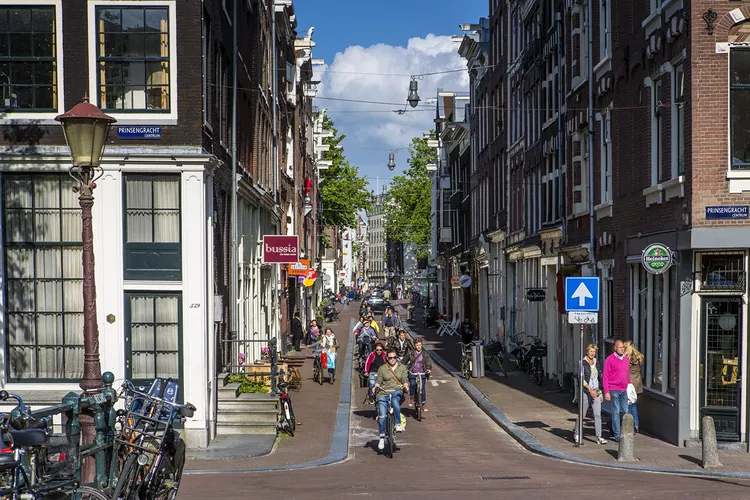Summary
Biking in Amsterdam is a quintessentially Dutch experience, and it’s by far the most popular and efficient way of getting around. However, Amsterdam’s frenzied flow of traffic and confusing streets can intimidate visitors on two wheels. Therefore, read these tips for keeping yourself and your bike safe before you hop on your cruiser.
1) Know Where to Ride
Amsterdam’s 400 km (249 miles) of bike lanes and paths (fietspaden) make city cycling safe. They usually run along the right sides of streets. Moreover, some two-way lanes are on one side only and typically feature white lines and bike symbols painted on the road or on the reddish-colored path.
Amsterdam traffic uses the right side of the road, including bikes. Many streets in the historic center and along canals don’t have bike lanes at all. Just ride with traffic here, or stay to the right to let motorists pass. Consequently, large cars and trucks will usually follow behind you.
2) Pay Attention to the Signs
Amsterdam has many signs and signals designed especially for cyclists. Some important ones include:
- Bike traffic lights: These lights shine red, yellow, and green in the shape of a bicycle at most major intersections. Always obey them. Trams and other traffic have their own lights that don’t always correspond. Use the traffic light meant for cars when a bike light doesn’t exist.
- Designated Bike Path/Route: This is a round sign with a blue background and a white bicycle. It indicates a bike lane or route.
- Bikes/Scooters Excepted: A sign with the word uitgezonderd (“except”) and a bike/scooter symbol means that bikers are the exception to the otherwise posted traffic rule. For example, a round, red sign with a white dash means no entry. Bikers are allowed entry if the white, rectangular uitgezonderd sign is also present.
3) Give Right of Way
Always give right of way to trams from any direction. Listen for the distinctive clanging of their bells.
As for all other vehicles and bikes, give right of way to traffic approaching from the right. Traffic coming from your left should give you the right of way. Taxis and buses often push the limits on this rule; therefore, err on the side of caution when they approach.
4) Forget the “When in Rome…” Adage
Local Amsterdam bikers tend to ignore red lights. They’re known to carry friends on the backs of their bikes, ride on sidewalks, zip past fellow bikers without warning, and even chat on phones while weaving through crowds. Consequently, these behaviors are not to be mimicked!
5) Use Your Hands
Use hand signals when you’re changing direction. Just point in the direction you want to go. This will alert motorists and other bikers to yield or refrain from passing you on that side.
When in doubt at intersections, dismount. There’s nothing wrong with getting off your bike and walking it through busy areas.
6) Don’t Get Stuck in a Rut
Steer clear of tram tracks—they’re just the right size to swallow bike tires. If you must cross the tracks, which you likely will at some point, do so at a sharp angle. Many suggested bike routes are tram-free, thus avoiding this issue.
7) Be a Defensive Biker
You may know the road rules; however, that doesn’t mean everyone does. The most common obstacles you’ll encounter on a bike are pedestrian tourists. They often walk in bike lanes and cross streets without looking. Watch for them and use your bell to get their attention.
Moreover, scooters frequently weave in and out of the bike lanes, speeding by and startling cyclists. When you hear them coming, stay to the right and let them pass.
8) Lock it When You Leave It
Never leave a bike unlocked, not even for a brief moment. Bike theft in Amsterdam is a significant problem, but it can be avoided.
Always lock your bike to a permanent structure like a bike rack, pole, or bridge with a heavy chain or U-lock. Be sure to secure both the frame and the front wheel with the lock. Also, immobilize the back wheel if possible. Most rental shops provide both types of locks.
Look for signs that say Hier geen fietsen plaatsen—”Do not place bicycles here.” If you ignore this signage, your bike could be confiscated.
9) Keep It Movin’ and Clear the Way
Try to keep pace with fellow bikers. You may ride two abreast as long as your pace doesn’t hold up traffic.
Never come to a complete stop in the bike lane or on the street. When you’re walking with your bike, do so on sidewalks or in pedestrian areas.
10) Use a Map
Not all Amsterdam streets are suited for cyclists, so navigating without a route plan can be inefficient and hazardous. Therefore, always use a map.
Most rental shops offer basic city maps/routes, but these can be somewhat limited. A highly recommended tool is the Amsterdam op de fiets—the “Amsterdam on the bike” map. It’s available at Amsterdam Tourist Offices and illustrates suggested bike routes, areas restricted to cyclists, bike repair shops (important for flat tires), tram lines, museums, and popular attractions. This map covers all of Amsterdam from northern islands to southern suburbs.





